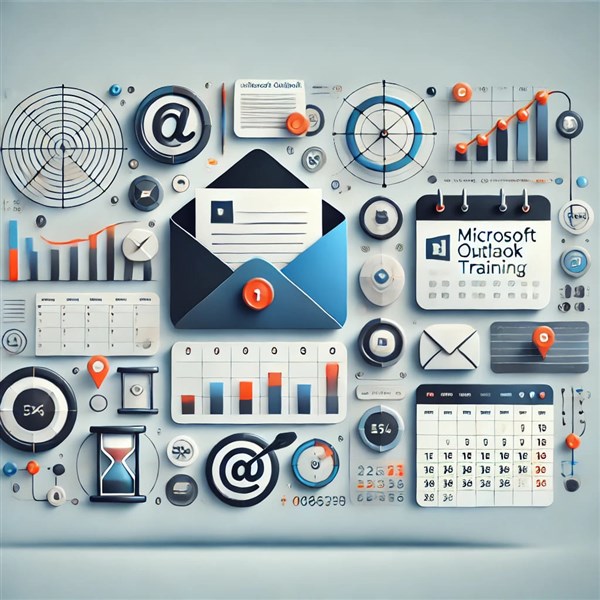We're open through the holidays to support your upskilling goals — book your session today!
We're open through the holidays to support your upskilling goals — book your session today!
Unable to find what you're searching for?
We're here to help you find it
In today’s digital-first workplace, email remains one of the most essential communication tools, and Microsoft Outlook is at the center of it all. Whether you’re scheduling meetings, managing tasks, organizing emails, or collaborating across teams, mastering Outlook can make a measurable difference in your day-to-day efficiency.
Yet despite its widespread use, many people only scratch the surface of what Outlook can do. That’s where a Microsoft Outlook training program comes in. Whether you're a total beginner or a daily user looking to sharpen your skills, structured Outlook training unlocks powerful features that save time, reduce errors, and boost productivity.
In this blog, we’ll walk you through exactly what you’ll learn in a Microsoft Outlook training program and why it’s a valuable investment for both individuals and organizations.
📬 What You'll Learn:
Most users rely on Outlook’s email functionality—but training goes deeper into mastering how to manage email like a pro. Outlook training teaches you:
💼 Why It Matters:
Email overload is a major time sink. Learning inbox zero strategies, automation, and advanced filtering helps you cut through the clutter and stay focused on important tasks.
📅 What You'll Learn:
One of Outlook's most powerful—but underutilized—features is its calendar. Outlook training covers:
🔑 Why It Matters:
Time management is everything. Knowing how to coordinate meetings effectively, avoid scheduling conflicts, and manage multiple calendars helps you and your team run more efficiently.
📇 What You'll Learn:
Outlook training helps you build and manage your professional network by teaching:
🤝 Why It Matters:
Whether you're working in sales, HR, or administration, keeping your contacts organized and accessible is crucial for professional communication and follow-up.
✅ What You'll Learn:
Outlook is more than an email tool—it’s also a powerful task manager. In training, you'll learn:
🚀 Why It Matters:
When emails turn into actions, managing them through Outlook tasks keeps your workflow centralized and boosts accountability.
🔄 What You'll Learn:
Why do things manually when Outlook can do it for you? Outlook training teaches you how to:
⏱️ Why It Matters:
These automation tools save hours each week, eliminate human error, and reduce decision fatigue by streamlining your repetitive tasks.
🔐 What You'll Learn:
In a world where email phishing and data breaches are common, Outlook training includes:
🔒 Why It Matters:
Security isn't just IT’s responsibility. Being trained in Outlook’s privacy tools helps you protect sensitive information and comply with workplace policies.
🔗 What You'll Learn:
Outlook is part of the broader Microsoft 365 ecosystem. Training teaches you how to:
🧠 Why It Matters:
The ability to switch between tools without breaking focus is a massive productivity boost. Integration ensures your workflow remains smooth and connected.
🎨 What You'll Learn:
Make Outlook work for you with training that covers:
⚙️ Why It Matters:
A tailored Outlook experience helps you work faster, more comfortably, and with fewer distractions.
📥 What You'll Learn:
If you're an executive assistant or part of a team managing shared resources, Outlook training will teach you:
🧑💼 Why It Matters:
In a team setting, shared mailbox mastery ensures smooth collaboration and prevents dropped communications or duplicated efforts.
📱 What You'll Learn:
Outlook training often includes how to:
🏠 Why It Matters:
In a hybrid or remote work world, managing Outlook on the go ensures you’re productive and responsive, no matter where you are.
Conclusion
A Microsoft Outlook training program offers far more than just email basics. It equips you with the skills to communicate effectively, manage your time, automate routine tasks, and collaborate seamlessly across platforms.
Whether you're an individual looking to boost your productivity or an organization aiming to train employees in digital workflows, investing in Outlook training is a step toward smarter work and better outcomes.
From mastering inbox organization to leveraging automation and integrations with Microsoft 365, the right training will make Outlook your most powerful productivity tool.
When it comes to IT training, Koenig Solutions is a leading name in the industry. With a wide range of courses on offer, Koenig provides comprehensive training in top technology courses, including Microsoft Outlook. With a team of certified trainers and industry experts, Koenig ensures you get the best training experience.

Aarav Goel has top education industry knowledge with 4 years of experience. Being a passionate blogger also does blogging on the technology niche.










